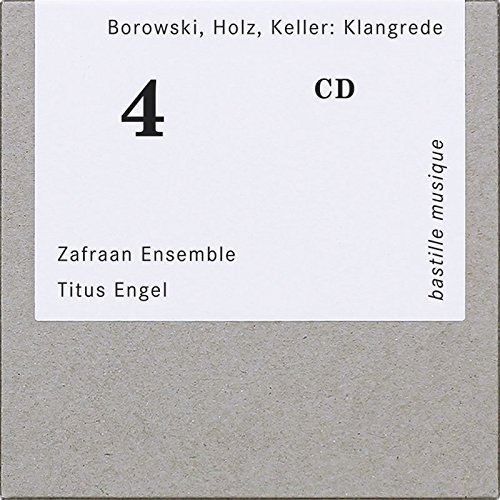MEDIA
January 2016
Junge Klangrede
Leonie Reineke
Quintett (2009)
Liam Mallet - flute
Miguel Pérez Iñesta - clarinet
Josa Gerhard - viola
Clemens Hund-Göschel - piano
Anna Viechtl - harp
Titus Engel - conductor
The piece "Quintet" is based on harmonic progressions that are functionally connected to a central sound. I was interested in perceptual principles such as consonance and dissonance, terms derived from tonality. The idea was to apply them in a musical language that is not tonal in the historical sense.

Klangrede
Kataklothes (2015)
for large ensemble
Quintett (2009)
for flute, clarinet, viola, piano and harp
Zafraan Ensemble, Titus Engel
Original Release Date: 2016
Number of Discs: 1
Label: bastille musique 4
Run Time: 69.34 minutes
ASIN: B01N8XERA5
Longlist 01/2017 of Preis der deutschen Schallplattenkritik
![]()
Five stars deluxe
The CD is recommended by the Neue Zeitschrift für Musik:
The concert of the Zafraan Ensemble with pieces by Johannes B. Borowski, Eres Holz and Stefan Keller was one of the most remarkable, most alive concerts at Ultraschall: Festival for Contemporary Music 2016 in Berlin. With all the differences in musical rhetoric, the individual pieces have the will to complex structures and energetic sound processes in common, which, in the brilliantly playing Zafraan ensemble, transform into a tangible sense of soundness.
Dirk Wieschollek
Die erwähnte „Tonikalität“, den Eindruck eines tonalen Zentrums, versucht er durch bestimmte Techniken jenseits der Prinzipien von Dur-Moll-Kadenzen erfahrbar zu machen. Der Zentralton fis im Quintett wird strukturell mit verschiedenen Mitteln bestätigt, etwa durch regelmäßige Wiederholungen dieses Tons oder satztechnisch durch Verdoppelung des Tons in den Stimmen und durch die Assoziierung dieses Tons mit einer bestimmten Akkordkonfiguration. Steigerungspassagen, Spannungsfelder und Bewegungen in höhere Register werden als Strategien zur Erzielung einer bewusst verfolgten musikalischen Dramatik eingesetzt. Dadurch gelingt...
read more
Eckhard Weber
Rundfunk Berlin-Brandenburg (RBB)
Berlin, 2015
Eres Holz's Quintett (2009) for flute, clarinet, viola, piano and harp (conducted by Titus Engel) starts with an elegant sparsity of texture, a feeling of fragments linking into a whole. Not for the last time on the disc I thought of the influence of Pierre Boulez, with Messiaen perhaps in the background. Whilst there are some interestingly dense moments, a characteristic of the performance is the great clarity which the players bring to the music, clarity and elegance. And the piece finishes as mysteriously as it starts.
read more
Robert Hugill
Planet Hugill - A world of classical Music
2017
Holz etwa schafft in seinem Quintett für Flöte, Klarinette, Viola, Klavier und Harfe (2009) tonale Gravitationsfelder jenseits der Dur-Moll-Harmonik und untersucht die Möglichkeit der Erzeugung von Spannungen und Tendenzen zur Auflösung – mithin also Kennzeichen, die für die musikalische Rhetorik von großer Bedeutung sind.
read more
Stefan Drees
06/2017
Das Quintett (2009) von Eres Holz gibt sich als ein fast gediegen elaboriertes Ensemblestück mit komplexen Stimmbewegungen, die farbig zusammenfließen und wieder auseinanderdriften.
read more
Dirk Wieschollek
Neue Zeitschrift für Musik
05/2017